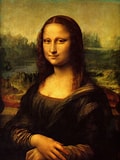Introduction
The Mona Lisa, painted by Leonardo da Vinci, is among the most famous paintings globally. The artist painted the Mona Lisa due to his fascination with the way light appears on curved surfaces. The image involves a half-body portrait of a woman, and the enigmatic smile of the lady reflects the artist’s idea of the connection between nature and humanity. The excellent and beautiful Mona Lisa painting contains various elements of art, such as line, color, and shape, as well as the principles, for instance, emphasis and rhythm.

Line and Texture
Leonardo da Vinci used numerous elements of art in Mona Lisa, for instance, curved lines to represent comfort, loveliness, and gentleness. The picture contains several repeating lines from the clothing folds and the road in the background. Leonardo da Vinci used oil painting which created a smooth texture and slightly glossy surfaces; however, the far set contains slightly rougher underpaintings. Numerous shadings give the figure shape outlining areas where the forehead turns to hair and clothing changes to a hand.
Color, Shape, and Space
Moreover, the face of the Mona Lisa painting contains warm colors such as orange, yellow, and red, while the background contains cool colors, for instance, green and blue. The artist used realistic quantities of darker shades for shading. The hair comprises layers of transparent color that are slightly thick, contributing to the glowing appearance of the lady’s face (Keshelava 17). Mona Lisa’s painting has a rectangular shape measuring 30 by 20 inches as the artist applied artistic principles to deliver an excellent piece. The figure also contains a sense of depth since it is angled on a chair and background. The figure seems to consist of three triangles, with the lady being the biggest and two locations on the left top and right top corner. It is a two-dimensional space picture having height and width as well as illusionistic with atmospheric perspective.
Balance, Emphasis, and Subordination
Leonardo da Vinci applied the principles of art while painting Mona Lisa, for instance, asymmetrical balance. The woman exerts weight on a single side of the painting; however, there is still balance despite the figure’s positioning being off-center. The image emphasizes the woman’s facial expression since she is smiling, and her eyes fall directly in the viewers’ center of vision (Keshelava 18). The smile and the eyes make a subtle expression challenging to capture in most photographs and paintings. The less visually exciting areas are the right and left backgrounds since they seem faded, lacking distinct features or information.
Scale and Proportion
The scale and proportion of the Mona Lisa can be explained using Botero’s version of Mona Lisa, which possesses a similar manipulation. The latter results in distortion of the painting since it has a massive head to body presenting a child-like figure. The Mona Lisa portrait lies in a well-structured space and is painted to a reasonable scale. It is half-length of a woman from head to the waist.
Conclusion
Mona Lisa portrait by Da Vinci implies the elements and principles of art such as emphasis and coordination. The painting has curved lines to indicate comfort and loveliness and a reasonable amount of darker colors for shading. It comprises three triangles with a lady occupying the most prominent space and two left and suitable backgrounds, both being at the top. The positioning of the picture is off-center, exerting weight on one side, thus making it have asymmetrical balance. The emphasis is on the woman’s facial expressions, and the background is less attractive due to inadequate details.
Work Cited
Keshava, Grigol. “Analysis of Leonardo da Vinci’s Mona Lisa del Giocondo.” International Journal of Health Sciences, vol. 8, no. 3, 2020, pp. 17-20.